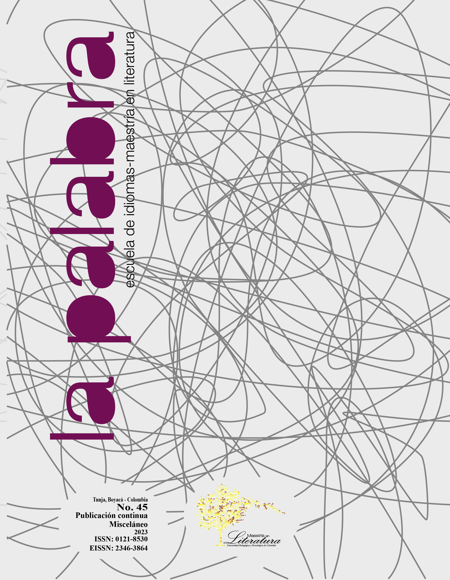“The Sweet Sounds of the Infinite Instruments” from the Decameron

Abstract
The presence of musical lexicon, representations and images in Boccaccio›s Decameron is a well-known and recurrent element in the development of the work, despite its traditional consideration as one of the decorative elements of the plot. In this article we will try to highlight how this presence constitutes a principle of internal cohesion in the text that contributes to the maintenance of its unitary structure. With this objective, we will analyze different steps of Boccaccio›s work, related to music, highlighting the structural function they develop in the narrative. The result of these analyses confirms the centrality that music acquires in the narrative frame of the work, where Boccaccio›s literary project and the narrative purpose of the ten protagonists are expressed. Finally, some conclusions on the Decameron musical plot will be presented, indicating its relevance for an organic reading of the literary configuration of this book.
Keywords
Decameron, Bocaccio, narrative, structure, music
Author Biography
Chiara Capuccio
Chiara Cappuccio, contract professor. PhD in Italian Literature at the Department of Romance, French, Italian and Translation and Interpretation Studies at the Universidad Complutense de Madrid (Spain). PhD in Italian Literature and specialist in the relationship between medieval Romanesque literature and music. Member of the Research Group Poéticas de la Modernidad: de la Edad Media a José Ángel Valiente, antecedentes y continuadores and of the Research Group Voces Africanas (GIVA) of the Universidad Complutense de Madrid.
References
- Alighieri, Dante. Divina Comedia, editado por Rossend Arqués, Chiara Cappuccio, Carlotta
- Cattermole, Raffaele Pinto, Juan Varela-Portas y Eduard Vilella. Madrid, Akal, 2021. Impreso.
- Boccaccio, Giovanni. Decameron, editado por Vittore Branca. Torino, Einaudi, 1987. Impreso.
- ---. Decamerón, editado y traducido por María Hernández Esteban. Madrid, Cátedra, 2014 (1ª edición: 1994). Impreso.
- ---. Decameron, editado por Amedeo Quondam, Maurizio Fiorilla y Giancarlo Alfano. Milano, BUR Classici, Rizzoli Libri, 2013. Impreso.
- Bonaventura, Arnaldo. Il Boccaccio e la musica. Studio e trascrizioni musicali. Torino, Bocca, 1914. Impreso.
- Cappuccio, Chiara. “Matelda e Beatrice tra salmodie ed echi profani:dicotomie e complanarità”, Italian Quaterly, XLVIII, 2011, pp. 5-32. Impreso.
- Cerocchi, Marco. Funzioni semantiche e metatestuali della musica in Dante, Petrarca e Boccaccio, Firenze, Leo S. Olschki Editore, 2010. Impreso.
- Ciabattoni, Francesco. “Music in Trecento Italy and the soundtrack of Boccaccio’s Decameron”, MNL, 134S, 2019, pp. 138-151. Impreso. https://doi.org/10.1353/mln.2019.0063
- De Ventura, Paolo. “Il preludio al Purgatorio: la funzione istituzionale della musica nel canto di Casella”. Critica letteraria, vol. 40, núm. 155, 2012, pp. 1-32. Impreso.
- Fritz, Jean-Marie. “Concezione e rappresentazione del suono nel Medioevo: dall’udito al paesaggio sonoro”. Atlante storico della musica nel Medioevo, editado por Vera Minazzi y Francesco Alberto Gallo. Jaka Book, 2011, pp. 142-145. Impreso.
- ---. Paysages sonores du Moyen Age. Paris, Champion, 2000. Impreso.
- Gallo, Francesco Alberto. “Boccaccio e gli inizi della poesia per musica”. Autori e lettori di Boccaccio, editado por Michelangelo Picone. Cesati, 2002, pp. 403-408. Impreso.
- Linskill, Joseph. The poems of the Troubadour Raimbaut de Vaqueiras. The Hage, Mouton & Co, 1964. Impreso.
- Menetti, Elisabetta. La realtà come invenzione. Forme e storia della novella italiana. Milano, Franco Angeli editore, 2015. Impreso.
- Pertile, Lino. La puttana e il gigante. Dal “Cantico dei cantici” al paradiso terrestre di Dante. Ravenna, Longo Editore, 1998. Impreso.
- Picone, Michelangelo. “La ‘ballata’ di Lisabetta (Decameron IV.5)”. Cuadernos de Filología Italiana, Número extraordinario, 2001, pp. 177-191. Impreso.
- Pirrotta, Nino. “Lirica monodica trecentesca”. Rassegna musicale, 1936, pp. 317-329. Impreso.
- Recio, Roxana (2013). “Música y canciones en Boccaccio: la nueva narrativa europea”. Los viajes de Pampinea: novella y novela española en los Siglos de Oro, editado por Isabel Colón Calderón, David Caro Bragado, Clara María Martínez y Alberto Rodriguez de Ramos. SIAL Ediciones, pp. 29-46. Impreso.
- Tufano, Ilaria “‘Qual esso fu lo malo cristiano’. La canzone e la novella di Lisabetta (Decameron IV.5)”. Critica del Testo, vol. 10, núm. 2, 2007, pp. 225-239. Impreso.
- Tonelli, Natascia. Fisiologia della passione. Poesia d’amore e medicina da Cavalcanti a Boccaccio. Firenze, Edizioni del Galluzzo, 2015. Impreso.
- Zumthor, Paul. La letra y la voz. De la literatura medieval. Madrid, Cátedra, 1989. Impreso.
